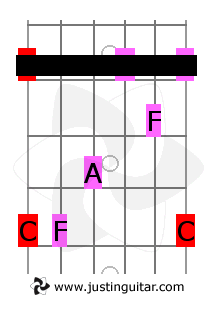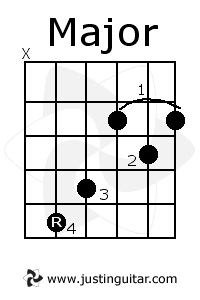
Moving onto the next shape we have a few more red "unused notes". These will be explained more a little further down the page.
Check out this next shape - this time in purple.

Still we only use the notes F A and C but they form a useful and common shape. Also notice that the 'root note' is now on the 5th string.
Now lets look at it more closely and I have put a barre over the fifth fret so you can clearly see the shape...
Imagine that the big black barre is the nut... ignore the red dots... can you see it?

It's an open C chord shape!
This shape is often called the "C Shape" barre chord. You know it is the chord F but the parent shape of the chord is the common open C chord shape. Hopefully, you are getting the idea now :)
This shape is also referred to as Position 3. Be sure to understand the "C shape" and "Position 3 " mean the same things depending on who teaches them.
Remember too that every shape on the guitar that DOES NOT use open strings is moveable. And this one is no exception.
It is usually played like this:

Now as you may know there are many ways of playing an open C chord. Sometimes (especially back in the 50's and 60's) it was played using your 3rd finger on the 6th string and your 4th finger on the root note. Think about it - they are all chord tones, and it sounds pretty cool. Most of the time we want the root note to be the lowest note though - that why it is the way that you have probably learnt it :)
Also see the red note on the thinnest string. Try playing an open C chord and adding that note in - sounds cool eh :) - I use it in my arrangement of the Beatles song Yesterday - it can really make a nice change from the "usual" C shape :) - but it is very hard to play as a barre cos we don't have enough fingers :))
When playing a C- shape barre, these two options become difficult - unless you have five fingers! :)
Only two shapes to go now - CAGED - More Shapes (A).